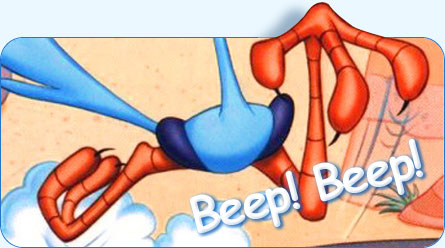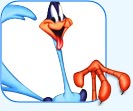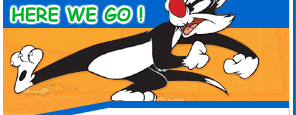The Road Runner shorts
are very simple in their premise: the Road Runner,
a flightless cartoon bird (loosely based on a real
bird, the Greater Roadrunner), is chased down the
highways of the Southwestern United States by a hungry
toon coyote, named
Wile
E. Coyote (a pun on "wily coyote").
Despite numerous clever attempts, the coyote never
catches or kills the Road Runner, and all of his elaborate
schemes end up injuring himself in humorous instances
of highly exaggerated cartoon slapstick violence.
There is almost never any "spoken" communication,
save the Road Runner's "beep-beep" (which
actually sounds more like "mheep-mheep")
and the Road Runner sticking out his tongue (which
sounds vaguely like a bottle being uncorked), but
the two characters do sometimes communicate by holding
up signs to each other, the audience, or the cartoonist
(though both these rules were broken later). Another
key element is that while Wile E. is the aggressor
in the series, he and his hopelessly futile efforts
are the focus of the audience's sympathy as well as
virtually all of the humor. Wile E. seems doomed,
like Sisyphus, forever to try but never to succeed.
The Road Runner lacks a developed personality and
is largely just an object, not a character.
Wile E. Coyote later appeared in some
Bugs
Bunny shorts, as well as the Little Beeper cartoons
featured on Tiny Toon Adventures, when he talks. In
the Bugs Bunny shorts in particular, he calls himself
a "super genius" and claims an IQ of 207
(Zip Zip Hooray!, 1965).
Scenery
The desert scenery in the first two Road Runner cartoons,
Fast and Furry-ous (1949) and Beep Beep (mid 1952),
was designed by Robert Gribbroek and was quite realistic.
In subsequent cartoons the scenery was designed by
Maurice Noble and was far more abstract. Several different
styles were used.
In Going! Going! Gosh! (late 1952) through Guided
Muscle (late 1955) the scenery was 'semi-realistic'
with an offwhite sky. A bright yellow sky made its
debut in Gee Whizzzzz! (early 1956) but was not used
consistently until There They Go-Go-Go!, later in
the same year.
Zoom and Bored (late 1957) introduced a major change
in the style of the rock formations, which became
much 'harder' in appearance, and often gravity-defying
in appearance. Except for Whoa Be-Gone (early 1958),
whose scenery design harked back to Guided Muscle
in certain aspects, this style of scenery was retained
as far as Fastest with the Mostest (early 1960). Hopalong
Casualty (mid 1960) changed the colour scheme, with
the sky reverting to blue, and some rocks becoming
off-white, while the bright yellow desert sand colour
is retained, along with 'sharp' style of rock formation
pioneered by Zoom and Bored. The Format Films cartoons
used a style of scenery which was essentially a paler
version of Hopalong Casualty's.
Learn more about
Road
Runner !
Text © Wikipedia 



